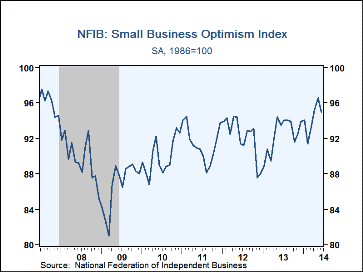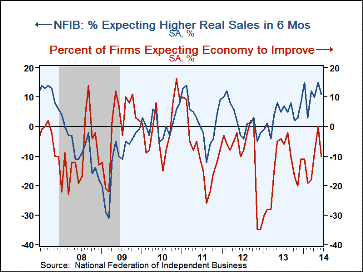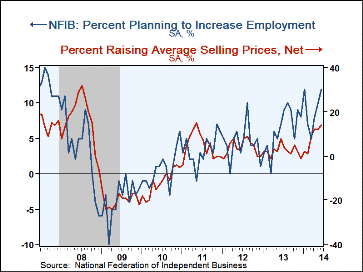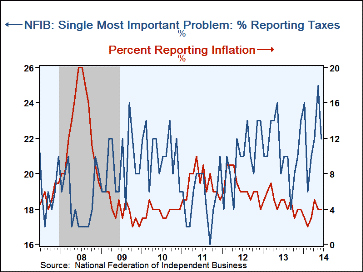 Global| Jul 08 2014
Global| Jul 08 2014U.S. Small Business Optimism Backpedals; Pricing is Firmer
by:Tom Moeller
|in:Economy in Brief
Summary
The National Federation of Independent Business reported that its Small Business Optimism Index slipped to 95.0 during June after improvement to 96.6 in May. The latest level remained near its highest since September 2007, just before [...]
The National Federation of Independent Business reported that its Small Business Optimism Index slipped to 95.0 during June after improvement to 96.6 in May. The latest level remained near its highest since September 2007, just before the recession began.
The decline occurred as the percentage expecting economic improvement retraced its May improvement. The percentage of firms expecting higher real sales in six months also pulled back to 11% following the prior month's rise. Working sharply lower to the least since February was the percentage of firms who thought that now was a good time to expand the business.
Working the other way was the percentage of firms planning to increase employment. At 12%, it was the highest level since January. The percentage with positions that could not be filled right now also rose to 26%, the highest level in seven years. The percentage indicating that credit was harder to get remained stable at a low 6%.
On the pricing front, a higher 14% of firms raised average selling prices, the most since May 2011 but a stable 21% planned to do so in the future. A higher 21% were raising worker compensation but a greatly lessened 13% were planning increases, the least since January.
The most important problems faced by small business were taxes (22%), government requirements (20%), poor sales (13%), quality of labor (11%), insurance cost & availability (9%), competition from large businesses (8%), cost of labor (4%), inflation (4%) and financial & interest rates (3%).
Roughly 24 million small businesses exist in the U.S. and they create 80% of all new jobs. The typical NFIB member employs 10 people and reports gross sales of about $500,000 a year. The NFIB figures can be found in Haver's SURVEYS database.
| National Federation of Independent Business | Jun | May | Apr | Jun'13 | 2013 | 2012 | 2011 |
|---|---|---|---|---|---|---|---|
| Small Business Optimism Index (SA, 1986=100) | 95.0 | 96.6 | 95.2 | 93.5 | 92.4 | 92.2 | 91.4 |
| Firms Expecting Higher Real Sales In Six Months (Net %) | 11 | 15 | 10 | 5 | 4 | 2 | 3 |
| Firms Expecting Economy To Improve (Net %) | -10 | 0 | -9 | -4 | -15 | -9 | -9 |
| Firms Planning to Increase Employment (Net %) | 12 | 10 | 8 | 7 | 6 | 4 | 3 |
| Firms With Few or No Qualified Applicants For Job Openings (Net %) | 43 | 46 | 41 | 41 | 39 | 35 | 32 |
| Firms Reporting That Credit Was Harder To Get (Net %) | 6 | 6 | 5 | 6 | 6 | 8 | 10 |
| Firms Raising Average Selling Prices (Net %) | 14 | 12 | 12 | 8 | 2 | 4 | 5 |
Tom Moeller
AuthorMore in Author Profile »Prior to joining Haver Analytics in 2000, Mr. Moeller worked as the Economist at Chancellor Capital Management from 1985 to 1999. There, he developed comprehensive economic forecasts and interpreted economic data for equity and fixed income portfolio managers. Also at Chancellor, Mr. Moeller worked as an equity analyst and was responsible for researching and rating companies in the economically sensitive automobile and housing industries for investment in Chancellor’s equity portfolio. Prior to joining Chancellor, Mr. Moeller was an Economist at Citibank from 1979 to 1984. He also analyzed pricing behavior in the metals industry for the Council on Wage and Price Stability in Washington, D.C. In 1999, Mr. Moeller received the award for most accurate forecast from the Forecasters' Club of New York. From 1990 to 1992 he was President of the New York Association for Business Economists. Mr. Moeller earned an M.B.A. in Finance from Fordham University, where he graduated in 1987. He holds a Bachelor of Arts in Economics from George Washington University.










